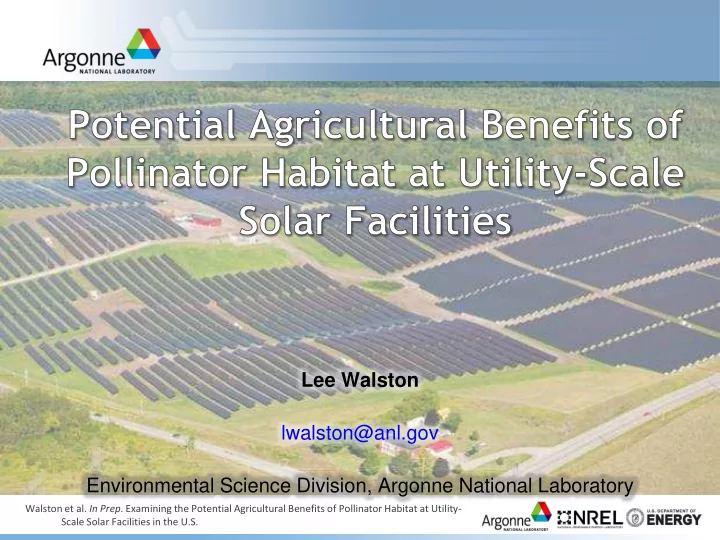

Lee Walston lwalston@anl.gov Environmental Science Division, Argonne National Laboratory Walston et al. In Prep . Examining the Potential Agricultural Benefits of Pollinator Habitat at Utility- Scale Solar Facilities in the U.S.
Utility-Scale Solar Development in the U.S. >1 MW ground-mounted installations that feed into the electricity grid Large spatial footprints: ~8 acres per MW Currently about 70 GW* (existing and planned): ~875 mi 2 *SEIA Major Solar Projects: https://www.seia.org/research-resources/major-solar-projects-list Desert Sunlight Solar Farm (San Bernardino County, CA) Groveland Solar Farm (Groveland, MA) 550 MW ~4,000 acres (6.2 mi 2 ) 3.6 MW 30 acres Agricultural Benefits of Solar-Pollinator Habitat 2
Utility-Scale Solar Development in the U.S. Over 2,200 existing projects (>600 planned) Average size: 12 MW Over 80% <25 MW Agricultural Benefits of Solar-Pollinator Habitat 3
Utility-Scale Solar Development in the U.S. Over 2,200 existing projects (>600 planned) Average size: 12 MW Over 80% <25 MW Agricultural Benefits of Solar-Pollinator Habitat 4
InSPIRE: Innovative Site Preparation and Impact Reductions on the Environment NREL-led effort to improve the landscape compatibility of large-scale solar projects through innovative siting practices – Focus on contaminated and previously disturbed lands – Co-locating solar projects on agricultural lands Evaluating vegetation performance under Co-location of solar and agriculture PV arrays Agricultural Benefits of Solar-Pollinator Habitat 5
InSPIRE: Innovative Site Preparation and Impact Reductions on the Environment Interest in restoration of ecosystem services of solar sites What about pollinator services through maintenance of solar-pollinator habitat? The establishment of regional flowering plants such as milkweed and other wildflowers, and soil preparation methods, either within the solar facility footprint area (e.g., beneath PV panels) and/or in offsite areas adjacent to the solar facility, that attract and support insect pollinators by providing nesting areas and a source of food. A B No Vegetation Turf Grass D C Onsite Offsite Pollinator Pollinator Agricultural Benefits of Solar-Pollinator Habitat 6
What is Solar-Pollinator Habitat? Pollinator Value No vegetation “Turf grass” “Pollinator friendly” seed mixes Something is better than Pollinator habitat diversity, Habitat management, nothing Soil management Agricultural Benefits of Solar-Pollinator Habitat 7
Making the Case for Solar-Pollinator Habitat Business case – Potential reductions in O&M costs with pollinator habitat (e.g., less mowing, risks) Ecosystem benefits – Increased biodiversity – Storm water & erosion control – Carbon storage – Agricultural benefits (e.g., pollination services) Despite the potential ecosystem service benefits of solar-pollinator habitat, little has been done to quantify these benefits. The first step towards quantifying the pollination service benefits of solar-pollinator habitat is to identify the areas of co-location where solar-pollinator habitat may be most beneficial to crop production. Agricultural Benefits of Solar-Pollinator Habitat 8
Quantifying Potential Solar-Pollinator Agricultural Interactions What if something was done at solar facilities? Cropland Data Layer, USDA National Agricultural Statistics Service Agricultural Benefits of Solar-Pollinator Habitat 9
Quantifying Potential Solar-Pollinator Agricultural Interactions Ten States with the greatest area within 1.5 km of existing and planned solar facilities. Total Total USSE Total Area Number of Electric within 1.5 km of USSE Capacity USSE Facilities State Name Projects (MW) (km 2 ) California 776 14,562 8,059 591 4,027 7,572 North Carolina 220 569 2,238 Massachusetts New Jersey 218 666 2,031 Arizona 111 2,528 1,647 42 2,701 1,456 Texas 61 2,458 1,301 Nevada Florida 40 1,105 1,070 Minnesota 168 489 1,059 Georgia 39 1,030 965 Total 2,266 30,135 27,298 (6.7 million acres) Agricultural Benefits of Solar-Pollinator Habitat 10
Quantifying Potential Solar-Pollinator Agricultural Interactions Total Amount of Pollinator-Dependent Agriculture Near Solar Facilities >0% dependence (Aizen et al. 2009) Over 850,000 acres 12 states with at least 1,200 acres Agricultural Benefits of Solar-Pollinator Habitat 11
Quantifying Potential Solar-Pollinator Agricultural Interactions Total Amount of Highly Pollinator-Dependent Agriculture Near Solar Facilities >40% dependence (e.g., Aizen et al. 2009) Nearly 90,000 acres Agricultural Benefits of Solar-Pollinator Habitat 12
Quantifying Potential Solar-Pollinator Agricultural Interactions Summary of Low & Moderately-Dependent Crop Types Near Solar Facilities These crop types near solar facilities have 1%-40% benefit from insect pollination (e.g., Aizen et al. 2009) Over 775,000 acres of these 10 crop types near solar facilities Agricultural Benefits of Solar-Pollinator Habitat 13
Quantifying Potential Solar-Pollinator Agricultural Interactions Summary of Highly- Dependent Crop Types Near Solar Facilities These crop types near solar facilities have >40% benefit from insect pollination (e.g., Aizen et al. 2009) Agricultural Benefits of Solar-Pollinator Habitat 14
Quantifying Potential Pollination Service Benefits Examples… 1. California Almonds Almond orchards are largely dependent upon managed honeybees for pollination. However, improved pollinator habitat near almond orchards may increase pollination by wild insects and improve the pollination efficiency of both managed and wild pollinators. The 29,718 ha (73,434 acres) of almond orchards near solar facilities in California represents nearly 8% of the Honey bees pollinating almonds. (Photo by UC-Davis, Kathy Keatley Garvey) total almond production in California, which is an industry valued at over $5 billion USD . Therefore, a 1% yield increase resulting from improved insect pollination efficiency associated with the maintenance of solar-pollinator habitat could be valued at over $4 million . Possible additional economic tradeoffs in relation to reduced honeybee rental fees ($300-$400 per acre). Agricultural Benefits of Solar-Pollinator Habitat 15
Quantifying Potential Pollination Service Benefits Examples… 2. Massachusetts Cranberries The 1,904 ha (4,705 acres) of cranberry bogs near solar facilities in Massachusetts represents approximately one-third of the total cranberry production in the state, which is valued at about $80 million USD (farm production value). Bumblebee pollinating cranberry. (Photo credit: University of Maine – Cooperative Research Extension) Therefore, a 1% yield increase resulting from improved insect pollination efficiency associated with the maintenance of solar-pollinator habitat could be valued at over $266,000 . Possible additional economic tradeoffs in relation to reduced honeybee rental fees ($200-$300 per acre). Agricultural Benefits of Solar-Pollinator Habitat 16
Quantifying Potential Pollination Service Benefits Next Steps… Economic analysis of solar-pollinator habitat benefits to agricultural production: • Biophysical characteristics • Pollinator communities • Crop value Field work to collect baseline data and measure pollinator service response to solar-pollinator habitat Agricultural Benefits of Solar-Pollinator Habitat 17
Questions? Agricultural Benefits of Solar-Pollinator Habitat 18
Recommend
More recommend